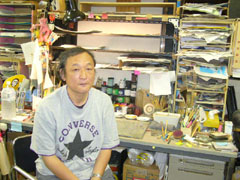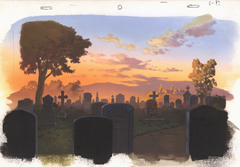Les 24 Chevaliers Part XI: Hiroshi Ono (Art Director)
Le Chevaler D'Eon is certainly presenting some of the most stunning background art seen in a TV production. Again, this is the result of thorough researches by the staff, and art director Hiroshi Ono, featured in this eleventh installment of Les 24 Chevaliers.
Part XI
Hiroshi Ono's In principio erat Verbum: "Sunset scenes"!
 | Hiroshi Ono Art Director. Ono currently heads Studio Fuga. He originally started at Kobayashi Production where he apprenticed under Shichiro Kobayashi. Ono's major works include feature films, Kiki's Delivery Service and Jin-Roh. In fact, Hiroshi Ono and Hiromasa Ogura (the chief at Atelier Ogura) had job interviews on the same day, and both of them joined Kobayashi Production immediately thereafter. |
First of all, what was your impression of Le Chevalier D'Eon when you first heard of the project?
Actually, I couldn't make up my mind whether to take the job. (lol) The information they gave me was enough to see that this was not going to be a straightforward job. The story takes place in Versailles and stretches from France to Russia and England. This means that you can't reuse the same background elements throughout the series, and instead you have to create new ones for each episode. Traveling stories are always the most difficult projects of all.
Le Chevalier D'Eon has a realistic story setting and graphic style, so I can't make it like a gag anime or a stylized design. I could do details to the level of a feature film if I wanted to, but if I did too much in the first episode, it would be tough from the second episode. So I had to think of ways to simplify pictures, but make them look real at the same time. When we actually started working on it, it was as hard as expected or maybe more. (lol)
How do you share the basic image and idea for the story with other background artists?
I'd basically draw the background for the first episode to get the idea of the artwork for the entire project. In the beginning, we are not that tight in terms of schedule, so I can do it myself then show the picture to the staff and let them see the idea. And I also correct the work myself, so they'd understand my point. That way I can coordinate the texture. And I usually show my colored rough drawings to give some idea.
You are also responsible for art design for this series.
I sometimes work on ten episodes at a time, including correcting the backgrounds. I draw designs for so many episodes that my thoughts are broken apart. (lol)
It seems like I'm using different sections of my brain to design and to draw backgrounds. When I am designing, I can't stand TV and music, but when I am drawing, I don't mind the sound; I even feel lonely without it. It might be that we draw with our senses so that we don't use the brain as much.
Is there any specific design in Le Chevalier D'Eon that comes to mind?
The Queen's chamber and the King's studio. There were a plenty of photos I could look at, but they were all taken from one direction. There was not one photo taken from the other side. It would have been acceptable if nobody knew about these places, but the building actually exists and there are people who might have seen the rooms, so it was challenging. I used photos from another room to get the ideas.
You might actually have people from France watch the program too.
When Japanese studios started contracting Korean facilities to do the animation background work, I heard that people could tell that they were not done by Japanese staff because of the roofs. Although both countries have tiled roofs, they look slightly different. But of course, even if we get a foreigner to draw Horyuji Temple, how many Japanese would know the exact structure of the temple in their mind? So it is important to fill in the gap where we lack the information and not miss the important points.
As depicted a lot in Le Chevalier D'Eon, your sunset scenes use blue and orange, which is not very common.
As I drew sunsets over and over, I came to pick this combination to create my favorite sunsets. Some directors ask me to use only orange, but I feel I need blue as well. I like the moment when the sky changes from orange to blue. The color in between orange and blue is tricky too. If you mix the wrong colors, you'll end up with a rather strange hue. Also, it's important to design something that's easy to draw, because when the project becomes a series, you will end up with a tight schedule. You won't want a design that requires extra time to draw.

What do you use as reference when you are putting together background images?
When I run out of ideas, I look at old paintings that are considered classic. I used to hate classics, so when Shichiro Kobayashi scolded me that I should be studying more from famous artists, I always picked up impressionist and abstract paintings. These days, I notice that the younger sequence directors and animators are picking up photographs to learn from. Layouts of key drawings look as if you are looking through a wide-angle lens. When we work on backgrounds, we have to redo the background drawn by key animators. We call this process, "sorting the key drawing." The wide-angle layout makes it difficult to create perspective drawings from key drawings.
I know it's easier to steal ideas from paintings. The coloring seems ideal to me too. I can't really pick one favorite painter, but I often get inspirations from art books. It's my turn now to tell young people to study classic paintings. (lol)
Lastly, please give a word to the people who are watching Le Chevalier D'Eon.
Although this is a TV series and the production time is limited, we have put in a lot of detail; even some parts that won't even come on screen. Please take a look at the background!
© Tow Ubukata · Production I.G/Project Chevalier 2006

![WORK LIST[DETAILS]](/contents/works/design/images/left_title.gif)



 terms of use
terms of use